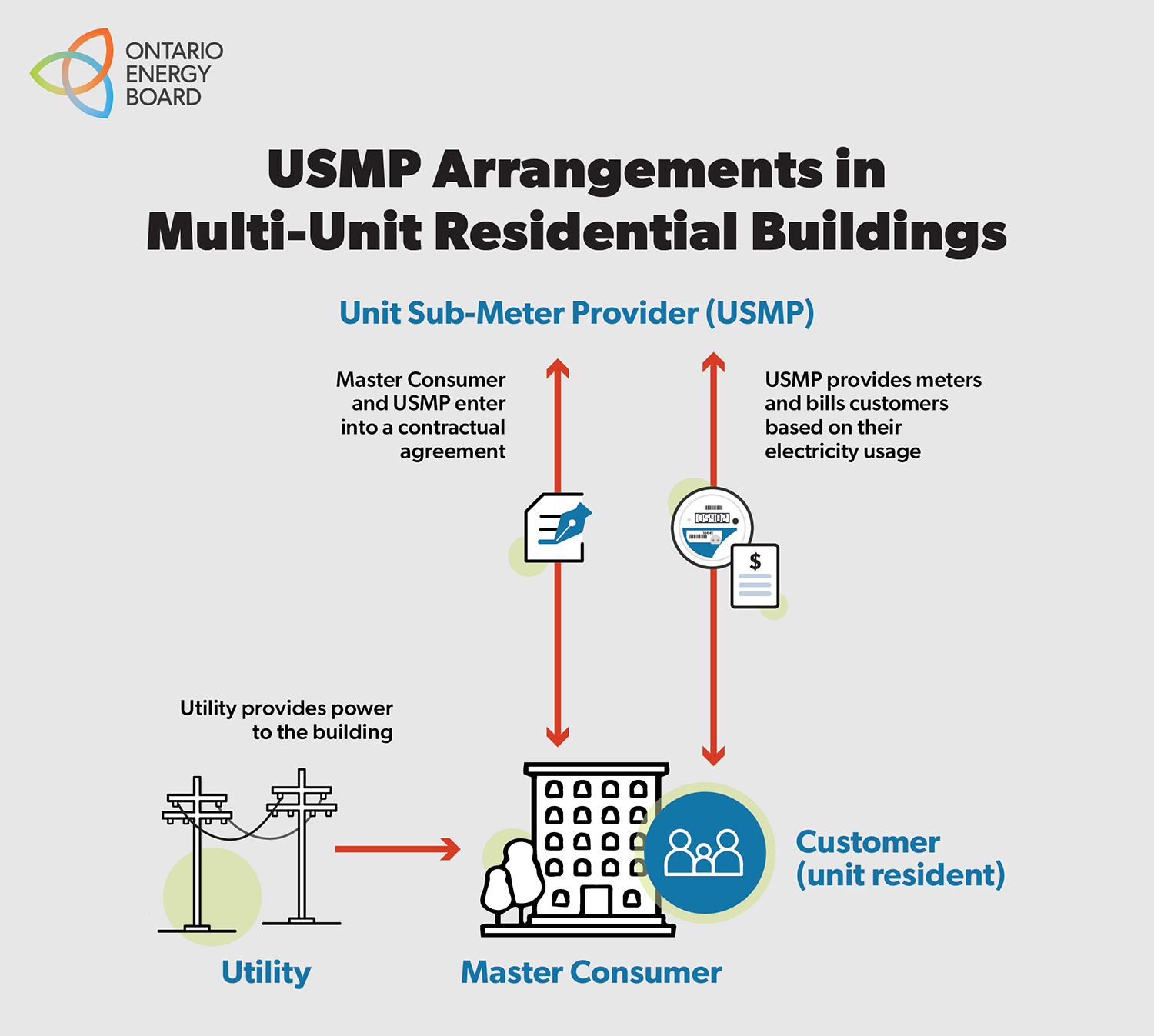If you live in a condominium or apartment, your unit has its own individual meter and your electricity bill comes from a company other than the local utility, you are a customer of a unit sub-meter provider (USMP).
USMPs are companies that provide electricity metering and billing services to customers in multi-unit buildings. The USMP enters into a contractual agreement with the master consumer. Master consumers include owners, landlords, property managers or condominium corporations. Those contractual agreements may determine fees, service charges and other terms of service.
The OEB licenses USMPs, and establishes and enforces rules and laws that protect customers.
USMP arrangements in multi-unit residential buildings
Master consumers choose a USMP to provide electricity metering and billing services to the residents of multi-unit buildings. Customers (unit residents) pay fees and service charges based on the contractual agreement made between the master consumer and the USMP.
Below is an example of this arrangement.

What customers need to know
USMPs provide the meters within the building and bill customers in the units based on their individual usage.
- The OEB regulates USMP services relating to electricity. We do not regulate other services that may be offered, such as billing for natural gas or water, or providing energy audits and efficiency recommendations.
- Bills include the unit’s share of electricity used and delivery costs charged to the building by the OEB-regulated local utility. These charges must be passed through to the customer with no mark up. The bills also include USMP fees and other service charges, such as account set up and disconnection/reconnection fees, as well as meter dispute charges.
- Customers of USMPs cannot switch between electricity price plans (Time-of-Use, Ultra-Low Overnight and Tiered prices). That decision can only be made for the building as a whole by the master consumer.
- The USMP's fees and service charges are not regulated by the OEB.
How the OEB protects customers
The OEB licenses USMPs and has established rules they must follow relating to business practices and customer service standards as set out in the Unit Sub-Metering (USM) Code. With a few key exceptions, these customer service rules are generally similar to those of electricity utilities. This includes rules about bill issuance and payments, security deposits, arrears payment agreements and disconnections process requirements.
- The master consumer makes the decisions on disconnection for non-payment. The disconnection is carried out by the USMP on the master consumer's behalf.
- The OEB’s winter disconnection ban does not apply to multi-unit buildings serviced by USMPs, although some may voluntarily comply.
- The OEB enforces rules and laws, including the Energy Consumer Protection Act, 2010 (ECPA). We can take enforcement action when a USMP is found to have broken the rules as set out in the ECPA, the USMP’s licence or the USM Code.
- The USM Code also requires USMPs to have Conditions of Service. This is where customers can go to understand their USMP’s operating practices and connection policies. To read more, see Section 3.2.5 of the USM Code.
- The Ontario government provides bill relief through the Ontario Electricity Rebate (OER). The OER is automatically applied to the electricity bills of most households including USMP customers. Learn more about the OER.
- Like utility customers, USMP customers who qualify may also receive financial assistance with their bill payments. The Low-income Energy Assistance Program (LEAP) and the Ontario Electricity Support Program (OESP) are available to eligible customers who need support. Learn more about these programs.
Have questions? We’re here to help.
Contact us or your USMP.